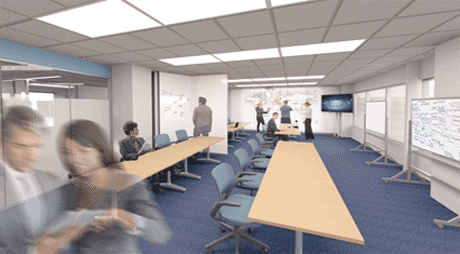Don’t present—Collaborate! —in Workspaces Designed to Inspire the Contemporary Knowledge Workforce

Even the perpetually frustrated cartoon character Dilbert might take heart if he were to find himself in a workspace that actually supported creativity in a flexible, casual environment designed for human beings. The fantasy is becoming reality as office design responds to technology-driven changes including global teams working from many locations, more people working remotely, the desire to communicate almost 24/7, and an exponentially increasing need to create and share knowledge fast and far. Workers unite!—in support of the workspaces of the future. —Editor
Author: Karen Fleer
Time to venture out of your office. The MITRE collaboration technology team, composed of Doug Phair, Lorin Petersen, Marc Cannava, John Hall, and Nate Jacobs, is implementing the results of a multi-year effort to understand and create the kind of work environment conducive to knowledge creation and sharing. MITRE recognized their work at the Knowledge Advantage showcase in May 2016.
This summer, entire floors at MITRE’s McLean, Virginia, campus are transitioning to “neighborhoods.” These neighborhoods retain individual offices and traditional corporate meeting rooms for presenting knowledge, but they are being enhanced by three new types of spaces that support creating and sharing knowledge:
Project Studios are designed for multi-session brainstorming—for weeks if needed. Users can write on every surface, and those valuable scribblings can be captured digitally and shared in real time with remote brainstorm participants who can connect to an interactive projector to do their own e-white boarding in real time. A Project Studio is endlessly reconfigurable: dividing walls can be moved as needed, and furniture is lightweight and height adjustable for people who like to think on their feet. The space is totally wireless so fast-moving brainstormers don’t trip over computer cables.
Collaboration Coves are perfect for co-editing documents. Multiple large displays are located very near desktops so collaborators can see document detail. More than one person can edit documents at the same time and switch between documents with a tap on a small device called a puck.
Huddle Spaces augment private offices, break rooms, and stairwells for impromptu small-group meetings. They provide “just enough” technology in the form of Collaborate and Capture boards that can save information for later retrieval by participants so the next great idea isn’t forgotten on the way back down the hall.
This kind of dramatic workspace change may be led by experts in knowledge sharing and office design, but its long-term success requires strong partnerships with IT (wireless, real-time information sharing) Human Resources (change management that helps employees get the most from new workspaces), and Corporate Real Estate (finding the right space for the task at hand).
MITRE sees its workspace transition as one way of meeting the rapidly changing demographics and emerging work styles of current and future MITRE employees. The key is to provide adaptable space that blends traditional individual work space with environments that are better suited for collaborative/social interaction. These innovative workspaces even have an impact on dress code—toward the casual—and on the emergence of more concentric and less hierarchical work styles.

0 Comments